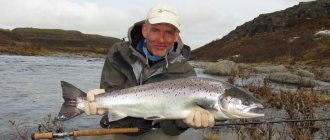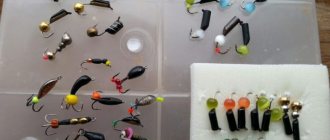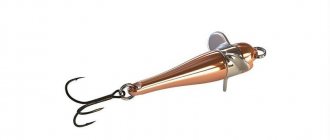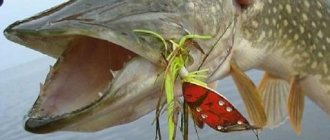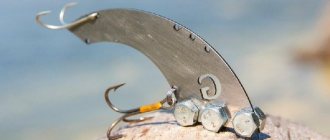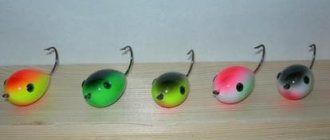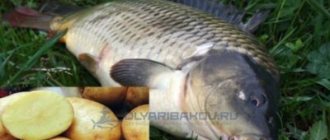Lure fishing in winter. There are many ways to fish from ice in winter. Jig fishing is the most popular, and recently the number of fans of angling predators on girders has increased, but vertical trolling is perhaps the least widespread.
The frozen reservoir is always full of jigs, red flags of the girders can be seen all around, and only a couple of fishermen are trying to shine. But with a good spoon, when used correctly, you can catch much more fish than with a jig.
Features of lure fishing
There are only two main reasons for the low interest in winter lures. Firstly, not always and not every predator can be interested in a spinner. Secondly, the variety of baits in this category leaves much to be desired. From the meager arsenal offered in fishing stores, it is difficult to choose truly catchy winter lures. For example, the high efficiency of the vaunted Swedish baits with a chain on many reservoirs in the middle zone of our country turned out to be doubtful. That is why, in order to successfully lure, many winter fishermen have to turn to artisans or make working lures themselves.
Some fishermen lack persistence and endurance. It's not just about bait. It’s not enough to have catchy lures; you also need to be able to look for fish, use various tactics that allow you to get a couple of “tails” even in the midst of the wilderness. Many beginners who tried to shine and did not see a single bite (the one that could become a powerful incentive) quickly return to jigs.
Meanwhile, lure fishing is no less exciting, exciting and rewarding than jig fishing. And under certain conditions it is even more effective. You just need to adapt to this method of ice fishing, learn to notice seemingly insignificant little things, learn to see and correct your mistakes, do everything correctly and consistently. Only with this approach does winter flashing become an exciting activity.
About gear for catching perch with a spinner
A fishing rod for trolling perch is selected with a sensitive and elastic whip made of high-modulus carbon fiber, fiberglass, etc. When fishing for active perch on verticals, you can use nodular gear; usually the sensitivity of a properly selected whip is sufficient.
If you fish for passive perch using bottom spoons, then the presence of a sensitive nod is mandatory. This is necessary to track the position of the spinner on the bottom, and as we found out, this is a very important aspect. The guard can be a nipple, a clock spring, a plastic plate, or a snot nod.
Such a nod bends downward under load, but when it touches the bottom it begins to unload. At the moment of unloading, position the spoon vertically. In a strictly horizontal position, the nod is a spoon at an angle of 40-50 degrees to the bottom of the reservoir. When completely unloaded and lifted up, it lies flat
The length of the fishing rod is selected based on fishing conditions. If the fishing is active and fishing is done while standing with a lot of movements from hole to hole, then a long fishing rod is needed, up to 60-80 cm. When fishing squat, when you have to drag out a passive perch for a long time, you should use ordinary fishing rods 30-40 cm long.
Therefore, depending on the season and what type and size of spinners are used, the length, stiffness and power of the rod are selected.
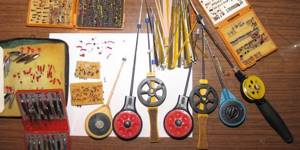
The fishing line for vertical trolling is selected with a diameter of 0.08-0.14 mm, a special heat-resistant monofilament. Since a thicker one will have a negative impact on the performance of the bait.
When trolling on bottom lures, thicker lines are used due to the fact that:
- bottom spoons usually weigh more than vertical spoons;
- trophies that fly on such baits are more respectable;
- the load and negative impact when fishing with bottom lures is greater and more aggressive (it hits the tee, the impact of the ground, the fish is larger), then the diameter of the fishing line too;
- so that the monofilament stretches less and playing at great depths does not lose efficiency.
Working diameter 0.18-0.22 mm.
Pike also likes to attack perch spoons, especially bottom ones. But we prefer to treat the cuts philosophically and not use a leash. Any leash changes the play of the spinner for the worse; the perch reacts very negatively to this. And one pike tail or cut is not worth it.
The fishing of perch can be promising throughout the entire freeze-up, even in the gloomiest winter, you just need to know its habits, ways of moving and stopping, as well as preferences in bait and their presentation, depending on the reservoir and the stage of winter. The goal of successful winter fishermen is to acquire this knowledge and apply it in practical classes in order to get beautiful humpback whales from under the water in elevator mode.
Choosing a spinner for a specific predator
By and large, the same pike or perch can be caught with any lure, so classifying lures of this type into pike, zander or perch is not entirely correct. When played correctly at a given depth, they all work against the main predators living in our reservoirs. Nevertheless, anglers divide winter lures according to this principle into 3 groups.
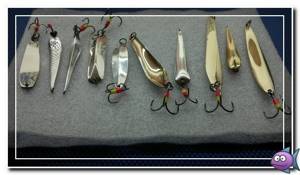
Perch - small curved spinners up to 30 mm long with a soldered or attached (ring, chain) hook. As a rule, their front part is wider and heavier. They are most often tied to the main line by the eye with a long loop, less often with a clasp. They are made from a wide variety of metal alloys. Today, many reputable manufacturers of fishing products produce winter spinners designed exclusively for catching striped robber.
Pike-perch are rather large, narrow-bodied spoons up to 80 mm long. Made in light colors, they imitate fatty bleak, which the fanged one loves very much. Winter bait for pike perch should not only be of high quality, but also “correct”. That is, to have an impeccable game, with repeated monotonous movements without errors. If you can find the location of a school of pike perch, such bait guarantees a catch. It has been noticed that in winter the fanged predator takes an active spoon more readily than a live bait frozen in the water column.
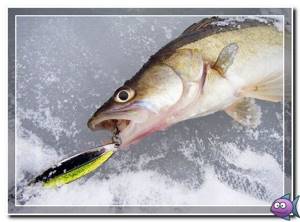
Pike are large spoons with a wide body. The most popular size is 60-70 mm. They are equipped with soldered single and double hooks or a suspended tee. Pike lures have a hole for a winding ring, to which a special leash is attached. The predator's teeth are very sharp, so fishing without a leash is fraught with the loss of expensive baits. Of course, a leash worsens the performance of the spinner and reduces the number of bites, but you have to put up with it.
Tackle for vertical trolling from ice
Today, fishing companies offer a wide selection of fishing rods for winter lure fishing. Fishing rods with bamboo and ebonite rods, the handles of which are made of balsa wood or foam plastic, have not yet become a thing of history. However, more and more often on the shelves of specialized stores you can see winter fishing rods made of more modern materials - vinyl plastic, nylon and others. Very practical are composite models, in which a small reel is attached to the handle. A telescopic whip is hidden in it. A large selection of gear is now on the market.
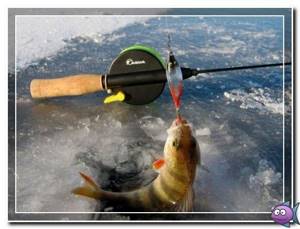
First of all, anglers take into account the performance characteristics of the fishing rod, as well as ease of use. Ideally, the tackle should be light and at the same time quite durable, with an elastic, sensitive tip, fit comfortably in the hand and not cause any problems to the angler during the fishing process. The power of the fishing rod depends on the fishing depth and the expected size of the prey. The rule is simple: the deeper the fishing and the larger the fish, the more powerful the fishing rod.
Each fisherman has his own preference regarding the reel. Some are quite satisfied with a simple inertia mechanism, while others find it easier to reel in hooked fish by rotating the inertia-free handle. The main thing is that the coil works without failures.
The fishing line is selected taking into account the size of the predator. It is necessary to understand that in clear cold water, too thick monofilament can alarm the fish. Experienced winter fishermen know very well that when the bite is bad, sometimes it is enough to reduce the diameter of the fishing line, and the underwater inhabitants will immediately become active. In addition, thick, coarse fishing line “smears” the movements of the spinner and does not allow it to play attractively.
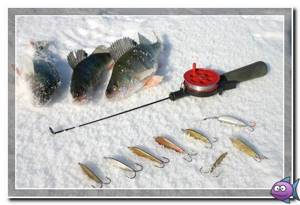
Do you need a nod when flashing? This question remains open. Modern technology has made it an optional element. Graphite and carbon fiber whips transmit the bite well into the hand, provided that the tackle is assembled correctly (the mass of the bait corresponds to the thickness of the fishing line and the elasticity of the tip). Those who still fish with old (Soviet) rough gear or homemade fishing rods cannot do without a nod. In this case, only he is able to clearly record the bite.
Double Zulu-Rig
A little trick will help to provoke the perch to bite - two baits coming after each other imitate the prey and the predator chasing it. This stirs up competition in the school of perch, and the predator takes it more confidently. There is a sifting out of small things - apparently, large perches consider themselves entitled to take away the prey and therefore more often end up as the catch of a spinning rod. This is how they fish with two baits on one rig, which is also called the Double Zulu-Rig.
How does double bait work?
The performance of the bait is determined both by the properties of the silicone and by the jig heads themselves. Soft silicone allows you to create a vibration that is attractive to fish, and beveled jig heads move the bait in different directions when jerking with a spinning rod.
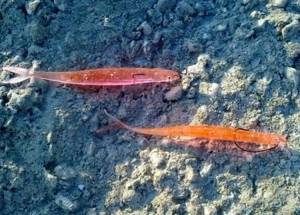
Usually this is the most varied game, the baits either come together or disperse over a long distance - up to 1 meter. All this creates more acoustics in the water and better attracts predators, as many anglers claim.
Watch a video about what a double bait is, how it plays in the water, and how to easily make a Double Zulu-Rig
Two scenarios for the game Double Zulu-Rig
The sizes and numbers of perch vary. Depending on the perch population, you can create two scenarios for playing with a double bait.
1. The flock effect. Lures emit a school of fish, which attracts a predator. In this case, two small (10 cm) similar silicone fish are mounted on the equipment. But you can also use foam rubber, which, as you know, makes more noise; perhaps a noisy school will have a better effect on the perch.
Such equipment is more effective in reservoirs where there are populations of large perches that form stable schools that do not let small fish pass by.
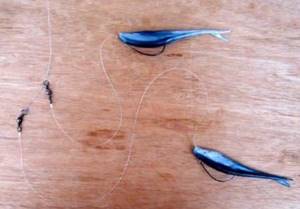
2. The chase effect. Here, a smaller front bait is used, and a larger rear one, and often the second bait is painted with stripes - the color of the perch. Then the predator located in the reservoir is simply obliged to grab the fleeing prey, ahead of the imaginary competitor.
These lures work best in bodies of water where predators are found in a wide range of sizes and where small fish tend to be outpaced.
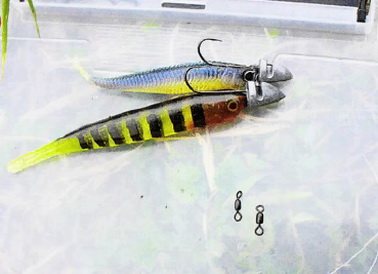
How to make a Double Zulu-Rig
A pair of leashes are attached to swivels. One swivel is put on the main line, and then the second is tied at the end of it.
Leashes of different lengths are attached to each of the swivels. Length varies - this is an experimental value. For example, lengths of 25 cm and 40 cm are considered suitable.
At the end of the leashes, jig heads are attached to winding rings. By selecting the weight and size of baits, you achieve the desired catching game.
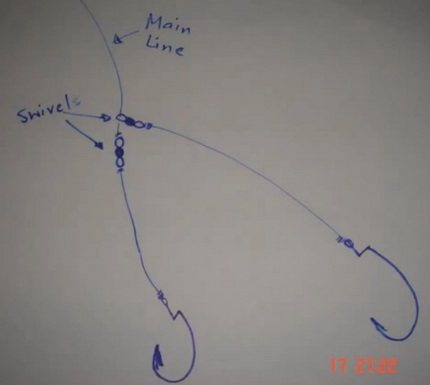
Posting the bait
Twitching the rod, hitting the blank, and the baits immediately begin their unique dance. But the game must be played where the bass are. Of course, the splashes reveal a hunting predator. But this does not always happen. Sometimes it is effective to test different horizons. First of all, you need to look for active perch by changing the depth of the survey. Moreover, it is not always necessary to change the catchable jig-head-bait set.
For example, using a load weighing 7–8 grams, you can first carry it higher, fishing the upper shallow horizons without scaring the lower fish. Here, reeling begins immediately after splashdown. The next fishing is carried out at a depth of approximately 3 meters. To achieve it, after casting you need to count to 5 and then start retrieving. Next, the deepest layers are examined, the bait is submerged on a count of 10.
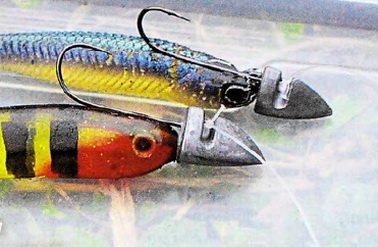
This simple example shows that fishing with a double bait is quite simple. Watch a video of how bass are caught in the USA using the Double Zulu-Rig.
Spinner fishing technique in winter
Perch
At the beginning and end of winter, perch is very active, greedily grabbing any food, so anglers don’t focus too much on the technique of using a spoon. The primary task is to make the striped one notice the bait. To do this, simply lower the spoon to the bottom, make three or four strikes on the ground (raise up the turbidity), and then use the standard technique for an active predator:
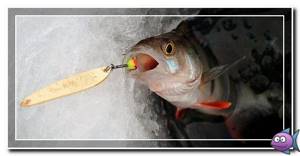
- with a short swing of the rod, the bait is thrown up about 40 cm;
- pause for 2 to 5 seconds;
- set the bait in motion again, working only with a brush.
The duration of pauses between tosses is selected according to the situation and depends on the activity of the striped fish. If the bite is very good, you don’t have to do them at all. In the middle of winter, when the predator is sluggish, you can seduce it with smoother play and longer stops. At this time, perch often attacks the bait during the pause.
Pike
Pike take best on wide and light spoons that glide well. Despite its gluttony, it is a very cautious predator that may suspect deception, therefore, when flashing, it is necessary to clearly perform every movement and constantly improvise. The basic playing technique is somewhat different from perch and looks something like this:
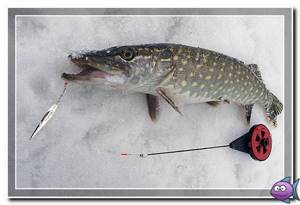
- two or three high-amplitude strokes;
- measured flashing with pauses of 5-6 seconds (at the lowest point);
- sharp throwing of the spinner to a height of up to 80 cm;
- another rise without a pause (no need to wait until the spoon reaches the bottom point).
In this way, it is possible to fish at two levels at once: in the near-bottom horizon and in mid-water. The toothy one reacts to the non-standard behavior of the bait, but in order not to spook it, it is necessary to follow the sequence of movements.
The above technique is suitable for fishing on the first ice and at the very end of the winter season. In the middle of nowhere, you can seduce pike only thanks to the clear rhythm and measured animation of the spoon. In most cases, it grabs the prey across the body, so for a 100% hook, you can solder an additional hook in the middle part of the bait. Of course, it will “ruin” the game a little, but the chances of getting the fish onto the ice double. A pike bite feels like a sharp blow to the hand and the appearance of heaviness. You should hook it right there, instantly. And no less energetically than the predator attacked.
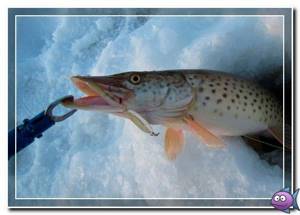
Zander
Pike perch is a schooling fish. If the fisherman is lucky enough to find a place where a “hungry group” has gathered, all that remains is to present him with the right bait. Usually the fanged one is caught in deep holes near the bottom. To begin with, you can try a simple technique that includes lifting the spoon 30-40 cm above the bottom surface, smoothly lowering it, and pausing for five seconds. If the predator does not respond, you will have to experiment with the vibrations of the bait and select a game that is attractive to him. At greater depths, techniques such as tapping and pulling along the bottom are often effective. In general, the technique of winter fishing for pike perch with a spinner depends on its activity. The better the bite, the sharper and higher the throws and the shorter the pauses.
Unlike its competitor, the pike, the fanged one shows interest in the bait carefully. The angler feels either a slight push or a tug on the line. You should hook confidently, with a wide wave of your hand, so that the hook's sting pierces the bony mouth of the predator.
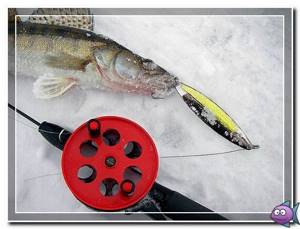
Lure success
In general, fishing with a lure should bring not only pleasure, but also results. Speaking about advice that should be given to a novice fisherman, it cannot be universal and depends on various factors.
The first is the choice of where to shine. Here it must be said that the methods of trolling will depend on the location of the cast and its distance. When fishing from the shore, you will have to cast far and be ready to quickly respond to any blow from the line, starting to reel in the fish. When fishing from a boat, you need to take into account some inconveniences when casting and body position.
The second thing you need to pay attention to is the choice of bait. In no case should you take just one spoon, because you cannot guess what the fish will bite on; yesterday it could take a spoon, but today it will only take a jig, or a combination of baits. Therefore, when going for lures, it is imperative to take several lures for different predatory fish, since one type of predatory fish can leave and another can come.
You also need to understand that casting to the same place is strictly forbidden. Predatory fish, when hunting, move throughout the entire reservoir, therefore, if you don’t catch it in one place, you don’t need to despair, but cast to another place and patiently wait for your catch. Well, the last thing you need to pay attention to is that the brightness of the bait must necessarily depend on the water. If it is dark, cloudy, then the bait is of bright colors, if it is transparent, then, on the contrary, dark.
Useful tips
- In winter, fish are more careful than in warm weather, so it is advisable to darken the hole by throwing a handful of snow into it.
- Finding a “cool spot” on an unfamiliar body of water is not that difficult. You just need to look around carefully and try to fish where there are the most holes.
- During the cold period, the fish behave sluggishly and do not want to waste energy chasing the fry, so during pauses there are often more bites than when the spoon rises or falls. However, stopping the bait is underestimated by many beginning spinners. Pauses seem like a waste of time to them, especially given the short daylight hours. But experienced fishermen know that a pause is the most important phase of winter trolling, without which it is sometimes impossible to provoke a predator to bite.

